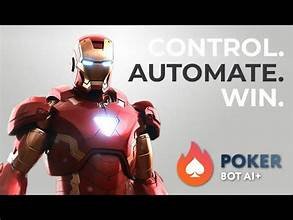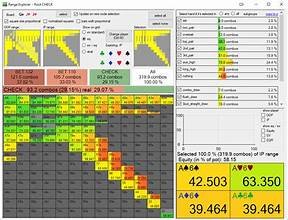THE ARTIFICIAL iNTELLIGENCE REVOLUTION
HOW AI IS RESHAPING STRATEGY FOR ONLINE & LIVE PLAYERS
The Artificial Intelligence Revolution.
AI is no longer a futuristic concept—it’s here, and it’s changing poker in ways we never imagined. From solvers that teach optimal play to real-time assistants helping online players, AI is reshaping how the game is studied, played, and even policed.
But here’s the real question: Is AI just another tool for players to sharpen their edge, or is it a threat that could kill poker as we know it?
While much of the focus has been on AI’s impact on online poker, there’s a growing concern that AI-powered strategies and even real-time assistance could find their way into live games—undermining the very essence of player skill, psychology, and decision-making.
This article isn’t about fearmongering. It’s about understanding the facts. We’ll break down:
How AI is already changing poker strategy.
What’s real and what’s overhyped?
The growing concerns for live poker.
How players can adapt and use AI ethically to improve their game.
Whether you’re a live pro, an online grinder, or a weekend warrior, you need to know how AI is reshaping poker—because ignoring it won’t make it go away. Let’s dive in.
THE RISE OF AI IN ONLINE POKER-MORE THAN JUST SOLVERS
When most players think about AI in poker, they think of solvers—powerful tools that analyze hand ranges, pot odds, and game theory optimal (GTO) strategies. And while solvers have been around for years, the AI revolution in online poker goes far beyond static analysis.
Today’s AI-driven poker tools include:
Real-time assistance – Some AI programs can provide players with GTO-approved actions during live hands, adjusting recommendations based on bet sizes, stack depths, and board textures.
Advanced HUDs (Heads-Up Displays) – AI-enhanced HUDs now offer deeper insights, predicting opponent tendencies and suggesting exploitative counter-strategies.
Automated Hand Tracking & Leak Analysis – AI tools don’t just record your sessions; they analyze them and identify mistakes you don’t even realize you’re making.
AI-Powered Opponent Profiling – Some software claims to recognize player styles over time and adjust recommendations dynamically, essentially turning poker into a game of who has the better AI assistant.
At the highest levels of online poker, it’s becoming clear: the players with the best AI tools aren’t just improving faster—they’re dominating.
THE ETHICAL LINE: AI ASSISTANCE VS. CHEATING
The poker community has long debated where to draw the line with AI tools. Studying with a solver before a session? Fair game. Using AI during a hand to tell you what to do? That’s outright cheating.
Yet, enforcement is tricky. How do online sites detect and prevent AI-assisted play? And as AI gets smarter, how long before real-time assistance becomes undetectable?
The implications for online poker are enormous—but this technology isn’t stopping at virtual tables. AI’s next frontier? Live poker. And that’s where things get even more concerning.
AI BOTS IN ONLINE POKER-FROM BASIC SCRIPTS TO PLURIBUS
Artificial Intelligence in online poker has come a long way. What started as simple, rule-based bots playing micro-stakes games has evolved into highly sophisticated AI programs capable of beating some of the best human players. The most alarming development? These AI bots are no longer just a threat to low-stakes grinders—they’ve reached the highest levels of the game.

Early poker bots were relatively easy to spot. They followed rigid betting patterns, played ultra-tight or ultra-loose, and struggled with anything beyond simple ABC poker.
As technology advanced, real-time solvers were integrated, allowing AI-assisted players to make GTO-perfect decisions on the fly.
Today, AI has surpassed human intuition in many aspects of the game. The biggest proof? Pluribus.
PLURIBUS: THE AI THAT BEAT THE PROS
In 2019, Pluribus became the first AI to consistently beat elite human players in six-max No-Limit Hold’em. Developed by Facebook AI and Carnegie Mellon University, this bot wasn’t just playing a fixed strategy—it was adapting on the fly, bluffing effectively, and even making counter-intuitive plays that confused world-class professionals.
Unlike earlier poker bots, Pluribus didn’t rely solely on brute-force calculations. Instead, it learned from real-world play, developed deceptive strategies, and made plays that looked human—but were even stronger.
It consistently outperformed top pros, including Chris Ferguson, Darren Elias, and Greg Merson, proving that AI isn’t just capable of playing optimally—it can outthink humans.
The scariest part? Pluribus required fewer computational resources than previous AI models, meaning similar technology could soon be widely accessible.
If an AI program can dominate at the highest stakes, what does that mean for online poker as a whole? It means AI-assisted play is already here, and it’s growing rapidly.
AI BOTS ARE ALREADY WIDESPREAD IN ONLINE POKER
HOW TO SPOT AI BOTS IN ONLINE PLAY
The impact of AI isn’t just theoretical—many poker sites have already been forced to crack down on bot rings and AI-assisted play.
Notable AI Cheating Scandals & Crackdowns
PokerStars Bot Ban (2019): Over 100 AI-assisted accounts were shut down, and the site refunded more than $1 million to affected players.
GGNetwork Crackdown (2020): The network seized funds from bot users and permanently banned accounts caught using AI-driven software.
Winamax Investigation: High-stakes games were dominated by suspected AI-assisted accounts, leading to multiple shutdowns.
America’s Cardroom (ACR) Controversy: The site faced accusations of bot-friendly policies, with top players calling for stricter enforcement.
These aren’t isolated incidents. AI-assisted play is a growing issue, and even when sites crack down, new bot rings keep emerging.
If you play online, you’ve likely faced AI opponents without even knowing it. While sites work to detect bots, here are some warning signs that you might be up against artificial intelligence:
- Unnatural Betting Patterns
Bots don’t get emotional. They follow statistically perfect lines without hesitation.
If an opponent never deviates from GTO, never makes an emotional call, or never shows hesitation, they might be AI-assisted.
- Inconsistent or Overly Precise Timing
Human players take longer on big river decisions and act quickly on snap folds.
Bots tend to have eerily consistent decision-making speeds, rarely deviating regardless of the situation.
- 24/7 Play Without Breaks
AI bots never get tired and often play long sessions without breaks.
If an account plays 12+ hours a day, every day, it’s likely automated.
- Unusual HUD Stats
If you use a tracking tool like PokerTracker or Hold’em Manager, look for VPIP/PFR ratios that seem unnaturally consistent across thousands of hands.
Some AI-assisted players play robotically perfect preflop ranges, which can be a red flag.

THE TRANSITION TO LIVE POKER: IS AI COMING FOR THE TABLES?
Until recently, AI bots were a problem only for online games. Now, with real-time solvers, wearable tech, and smart glasses, AI is creeping into live poker as well.
Think about it:
If AI can dominate high-stakes online games, what’s stopping players from using AI assistance in a live setting?
Hidden earpieces, smart glasses, and real-time solvers are already being used to relay optimal plays at the table.
The next section will expose how AI is infiltrating live poker—and why it could change the game forever.
aRTIFICIAL iNTELLIGENCE'S rOLE iN lIVE pOKER-tHE nEW fRONTIER
For years, live poker was considered immune to AI interference. Unlike online games, where every action is tracked and data is plentiful, live poker relies on human intuition, psychology, and real-time decision-making—things AI supposedly couldn’t replicate. But that’s changing.
With the rise of wearable technology, real-time solvers, and AI-driven game analysis, live poker is entering dangerous territory. AI isn’t just coming for live poker—it’s already here.
HOW IS Artificial Intelligence ENTERING LIVE POKER?
HIDDEN EARPIECES & REAL-TIME SOLVERS
AI’s presence in live games isn’t about bots sitting at the table—it’s about players secretly using AI-powered assistance in real time. Here’s how it’s happening:
Smart Glasses & Augmented Reality (AR) Devices
AI-powered smart glasses can display real-time GTO solutions directly on the lens, allowing players to access optimal decisions instantly.
A player wearing such glasses can discreetly analyze betting patterns, board textures, and opponent tendencies—all without ever needing to touch a device.
These devices can also record gameplay and feed it into machine learning models, helping players refine strategies over time.
Example: In 2022, rumors surfaced that high-stakes players were experimenting with AI-powered HUDs built into AR glasses—allowing them to play nearly perfect GTO live without ever needing a physical solver.
Players have been caught using hidden earpieces connected to an AI assistant feeding them real-time strategic advice.
With voice-activated solvers, a player could simply murmur their hole cards and board texture, and AI would instantly relay the GTO-approved move via a hidden earpiece.
This eliminates human error and allows players to execute mathematically perfect strategies without ever appearing suspicious.
Example: In 2023, casinos began cracking down on players using bone-conduction earpieces, which transmit sound through vibrations on the skull—making them almost undetectable.
WI-FI ASSISTED GAMEPLAY & REAL-TIME DATA ANALYSIS
AI programs can now process live game footage from hidden cameras or wearable devices, allowing remote assistants to analyze the action and relay optimal plays in real-time.
Players can connect to a remote poker coach or AI-powered solver via Bluetooth, receiving strategic advice as the hand unfolds.
Some poker rooms offer live-streamed cash games, meaning a remote AI assistant could track every action and provide feedback without the player needing to input anything manually.
Example: There have been reports of high-stakes private games being infiltrated by players using hidden AI analysis setups, allowing them to exploit recreational opponents with near-perfect accuracy
WHY THIS IS A PROBLEM FOR LIVE POKER
AI assistance fundamentally changes live poker in ways that make it nearly impossible to regulate. Unlike online play—where sites can track hand histories, betting patterns, and suspicious activity—live poker has almost no safeguards against AI interference.
- The Edge Is Unfair & Undetectable
A player using AI assistance has an insurmountable edge over traditional players.
AI-assisted players can mimic natural human behavior, making it impossible to detect unless they’re caught with a device.
Unlike traditional poker tells, AI doesn’t get nervous, emotional, or fatigued.
- AI Can Exploit Players Without Them Knowing
AI-driven software can track hand histories, opponent tendencies, and bet sizing patterns over multiple sessions.
This data is then used to construct highly accurate models of specific opponents, turning live poker into a purely mathematical contest.
- It Removes Human Skill & Creativity
The beauty of live poker has always been the human element—psychology, deception, and reading opponents.
AI doesn’t just level the playing field—it removes the need for real decision-making.
WHAT CAN BE DONE? sTOPPING AI IN LIVE POKER
If AI continues to infiltrate live poker, the game could be fundamentally altered forever. So what can casinos, players, and gaming regulators do to stop it?
BAN WEARABLE TECHNOLOGY AT THE TABLE
BLOCK WI-FI & CELL SIGNALS IN POKER ROOMS
IMPLEMENT AI DETECTION MEASURES
PLAYER VIGILANCE & REPORTING
No smart glasses, no AR devices, no hidden earpieces.
Casinos need to implement strict policies prohibiting electronic assistance, similar to how they handle card counters in blackjack.
Some poker rooms have already restricted smart devices at the table—but enforcement needs to be universal.
Some casinos have implemented signal-jamming technology, preventing players from using real-time solvers via Wi-Fi or Bluetooth.
By eliminating outside communication, players must rely on their own skill—not AI assistance.
Casinos could use facial recognition software to detect wearable tech and AR glasses.
Advanced scanning tools could detect hidden earpieces or bone-conduction devices being used for real-time coaching.
If players suspect AI interference, they need to report suspicious activity immediately.
Unusual betting patterns, lack of emotional reactions, and perfect GTO play over long sessions should be red flags.
AI’s role in poker is no longer just theoretical—it’s a reality. While AI can be an amazing study tool, its use in live games poses an existential threat.
If the game is no longer about human skill, adaptation, and psychology—then what’s left?
ADAPTING YOUR POKER STRATEGY IN THE ARTIFICIAL INTELLIGENCE ERA
AI has reshaped how poker is studied, but mastering AI-driven strategy doesn’t mean blindly following it. If you want to stay ahead, you need to understand how to adapt AI insights to real-world poker dynamics.
KNOW WHEN ARTIFICIAL INTELLIGENCE INSIGHTS ARE VALUABLE
AI-powered solvers and training tools excel at teaching theoretically sound decision-making. If you’re studying short-handed or heads-up poker, GTO-based strategies can provide a strong foundation for minimizing leaks and playing balanced poker. AI-driven analysis can also help break down hand histories, showing where you deviate from optimal play and where your tendencies may be exploitable.
However, poker isn’t played in a vacuum. What’s “optimal” in theory isn’t always the best approach in a live setting.

THE LIMITS OF AI & GTO IN LIVE POKER
AI thrives in mathematically pure situations, but live poker is messy, human, and unpredictable. This is where strict adherence to AI-driven GTO strategy falls short:
Multiway Pots: GTO is primarily designed for heads-up or short-handed scenarios. In a 9-handed live game, following GTO’s wide opening ranges or automatic continuation bets can get you into unnecessary trouble
Psychological Factors & Human Errors: AI assumes perfectly rational opponents—but most live players aren’t even close to playing balanced, GTO-style poker. If an opponent never folds to a c-bet, why are you betting just because the solver says so?
Exploiting Weak Players is More Profitable Than Balance: In live poker, most profits come from adapting to weaker opponents—not trying to “balance” your strategy so that they can’t exploit you. AI teaches balance, but in real games, adjusting to player tendencies is far more valuable.
USE AI TO SHARPEN, NOT REPLACE, YOUR POKER MIND
Instead of treating AI as an absolute authority, use it as a training tool. AI can help you:
Review hand histories and identify potential leaks.
Study equity calculations and improve mathematical decision-making.
Recognize pattern-based tendencies that can be applied to real opponents.
However, don’t become a robotic GTO player—the real edge in live poker still comes from understanding psychology, human tendencies, and game flow. AI can help sharpen those skills, but it shouldn’t replace your ability to think critically and adapt in real-time.
The players who benefit most from AI aren’t the ones who follow it blindly—they’re the ones who use it as a tool while staying flexible in their game.
If you want to future-proof your poker skills, understand how AI can help, where it fails, and when to rely on real poker instincts.
THE ARTIFICIAL INTELLIGENCE REVOLUTION IS HERE. ARE YOU READY?
AI has changed the way poker is studied, analyzed, and even played. From advanced solvers breaking down hand decisions to AI-powered HUDs influencing online poker, the impact is undeniable. And now, live poker is on the verge of its own AI transformation—whether players are ready for it or not.
But this isn’t the end of real poker, far from it. The players who thrive in the AI era will be the ones who understand when AI tools are helpful and when they fall short. They’ll use technology to sharpen their game, but they’ll also develop the adaptability, psychology, and real-world instincts that no AI can replicate.

2 thoughts on “The AI Poker Revolution: How AI is Reshaping Strategy for Online & Live Players”
Youre so cool! I dont suppose Ive learn something like this before. So nice to search out any individual with some original ideas on this subject. realy thank you for starting this up. this web site is something that’s needed on the web, someone with a little bit originality. useful job for bringing something new to the internet!
Hi there! This is kind of off topic but I need some advice from an established blog. Is it difficult to set up your own blog? I’m not very techincal but I can figure things out pretty fast. I’m thinking about setting up my own but I’m not sure where to start. Do you have any points or suggestions? Appreciate it
Comments are closed.